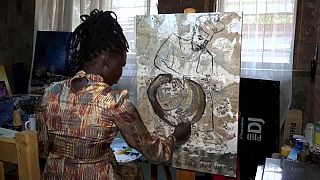Uganda
Twenty five year-old Martin Senkubuge spends much of his time locked in this small room which he has turned into an art studio on the outskirts of the Ugandan capital Kampala.
He uses a charcoal based paint to create extraordinary portraits, many featuring people with the skin condition vitiligo. Vitiligo is an autoimmune disorder which is clinically characterised by the development of white patches which are caused by a lack of working melanocytes, these are cells which produce melanin in the skin.
It can appear on particular limbs or the face and it can be a very disfiguring experience for people who have the disease.
Senkubuge learned about the disease while studying for his art degree. That first class degree is now being used to raise awareness about vitiligo and to educate people.
He's since learned about how the stigma of having vitiligo forces many people to avoid social situations, staying in isolation at home and sinking into depression. Senkubuge says some superstitious people in Uganda believe the disease is a bad omen.
Breaking the stigma
Senkubuge is most proud of the first portrait he produced for the cause and he's keen to show it. He says: "My first piece, wow, it was very special to me. It's called Vitiligo King and Vitiligo King is right here. Vitiligo King is a very special piece. It shows how someone like him that we have used, that some one like him has a story and how he has been out there with his body not covered."
Senkubuge says at first he wanted to paint the portraits for people with the skin condition. But now, after hearing their stories, he wants other people to understand what they are going through.
He says: "The main focus wasn't the public at the start, the main focus was the people themselves, because I wanted them to understand that we can make a change, they are sorrowful inside, most of them, some of them have not moved out of their rooms, some of them had never looked at themselves in the mirror, you know there is one guy who had never looked at himself in the mirror for 23 years, he is a father, he has a very beautiful young daughter but not looking at himself, why? Because of what he has been told."
Eva Atukunda, who was one of the models for Martin's first collection, experienced the stigmatization first-hand. Atukunda first started developing the condition after she had malaria at just ten years old.
Raise awareness
Even though there is little scientific knowledge about the cause of vitiligo, Atukunda says creating widespread understanding about the disease is the only way to change the way her society responds to the condition. She and others are hoping to make that change through the Vitiligo Association of Uganda.
"Vitiligo Association of Uganda we offer psychosocial support. Sp like I told you, when I met people that were like me I felt better about myself, so every time you meet people that are like you, you feel better so currently we are trying to establish support groups of people living with vitiligo in all the four regions of the country. So in those groups we offer support to those groups where members meet and then they counsel each other because when I share my story, you know there is power in sharing, you feel like a burden has lifted, especially if you are sharing with someone that has gone through the same experience with you."
Many patients try to hide their skin behind makeup and clothing because of different myths associated with the condition.
Dr. Okot, who works at the National Referral Hospital and also runs a private centre called the Ngozi Skin Clinic, says the condition most commonly affects the hands, face and neck and can occur in people of all ages. He says: "This problem is initiated by the immune system in an individual where you find that there are some antigens that are produced by the melanocytes, these are pigment producing cells which are found under the skin. These antigens which are produced under the skin within the melanocytes tend to sometimes go in a reaction with antibodies that are formed against the melanocytes antigens."
Okot adds that the number of people seeking treatment for vitiligo is gradually increasing as awareness about it grows.













11:05
Africa's hight cost of climate change [Business Africa]
01:16
Kenya investigates alleged abduction in Nairobi of Uganda opposition figure
01:16
Ugandan opposition politician kidnapped and jailed, his wife says
02:19
Thousands of refugees in Uganda struggle to get by, amid cuts in humanitarian aid
01:41
Victims of Uganda’s Lord’s Resistance Army disappointed in sentence
01:55
Uganda invests $3 billion in new railway system for efficient transport